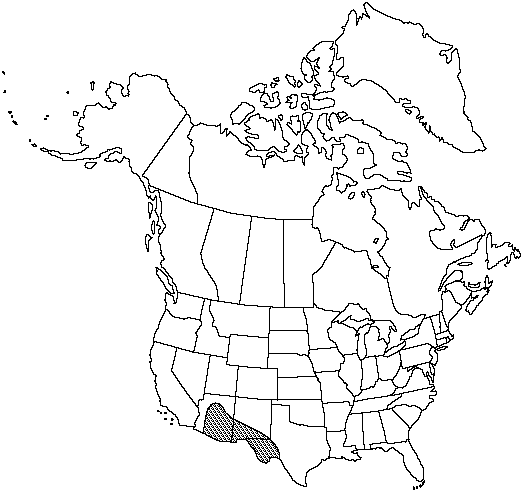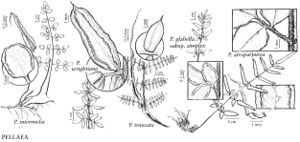Pellaea intermedia
Linnaea 38: 84. 1869.
Stems creeping, horizontal, slender, 2–4 mm diam.; scales mostly bicolored, narrowly lanceolate, largest scales 0.3–0.8 mm wide, centers black, thick, margins brown, thin, irregularly dentate. Leaves monomorphic, widely scattered along stem, 12–50 cm; croziers pubescent and bearing a few scales. Petiole straw-colored, tan, or gray, not lustrous, rounded or slightly flattened adaxially, without prominent articulation lines. Blade ovate to elongate-deltate, usually 2-pinnate proximally, 4–20 cm wide; rachis tan throughout, straight to slightly flexuous, rounded or flattened adaxially, ± pubescent. Pinnae perpendicular to rachis or slightly ascending, not decurrent on rachis, usually with 7–21 ultimate segments; costae straight to slightly flexuous, 20–100 mm, longer than ultimate segments. Ultimate segments ovate to elliptic, 5–15 mm, leathery, glabrous or usually puberulent abaxially; margins recurved on fertile segments, usually covering less than 1/2 abaxial surface, borders whitish, nearly entire; apex obtuse to slightly mucronate. Veins of ultimate segments obscure. Sporangia short-stalked, containing 32 spores, not intermixed with farina-producing glands. n = 2n = 87, 116, apogamous.
Phenology: Sporulating summer–fall.
Habitat: Rocky slopes and ledges, on a variety of substrates, including limestone and granite
Elevation: 300–2400 m
Distribution

Ariz., N.Mex., Tex., n Mexico
Discussion
Plants of Pellaea intermedia in the flora are apogamous triploids and tetraploids; a sexual diploid cytotype has been found near Saltillo, Mexico (A. F. Tryon 1968). Given the high degree of morphologic similarity among the three cytotypes, the North American polyploids probably were derived from the Mexican diploid through autopolyploidy.
Selected References
None.
Lower Taxa
"thick" is not a number.
